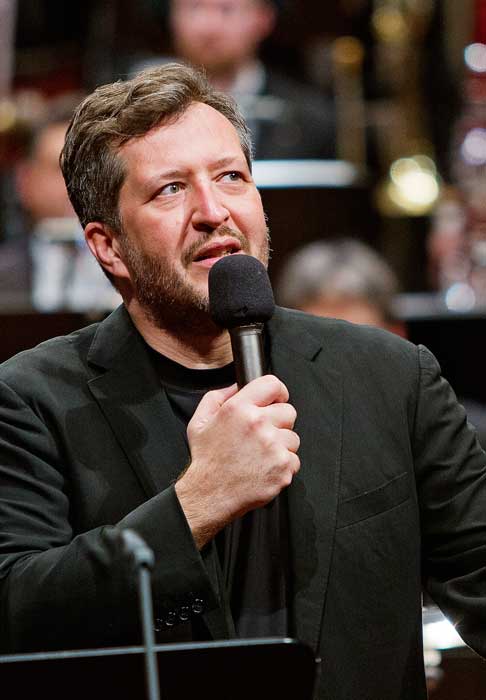léonie sonning music prize 2013
The British conductor Sir Simon Rattle received the Léonie Sonning Music Prize of 600,000 Danish kroner with a concert on 2 February at the DR Concert Hall. The concert was broadcast live on the Danish Broadcasting Corporation’s P2 radio channel and its DRK television channel.
Citation
The prize was presented by the conductor Michael Schønwandt, a member of the Léonie Sonning Music Foundation’s board, who gave the following reasoning:
‘The Léonie Sonning Music Prize 2013 of 600,000 Danish kroner is presented to the conductor Sir Simon Rattle in recognition of his placing of symphonic orchestral music at the centre of contemporary society for more than 35 years. With his captivating and revisionist performances of more than three centuries of music, Sir Simon has been instrumental in redefining the role and function of the conductor. Thanks to his enthusiasm and social commitment, numerous new listeners have opened their minds to the primordial power of music.’
In his own speech of thanks, Rattle announced that he would use the prize money to start a new conducting course as part of the Berlin Philharmonic’s Orchestra Academy.
Programme
Sibelius Symphony No 7
Abrahamsen Double Concerto for Violin, Piano and Strings
Nielsen Symphony No 4, The Inextinguishable
Dvořák Slavonic Dance Op 72 No 7 (encore)
Participants
Carolin Widmann, violin
Tanja Zapolski, piano
The Royal Danish Orchestra
Sir Simon Rattle, conductor
Simon Rattle in Denmark
As a very young conductor, Simon Rattle visited Denmark on several occasions in the late 1970s to give a series of concerts with the Copenhagen Philharmonic, at such venues as the Tivoli Concert Hall, Hvidovre Community Centre and Kastrup Cinema.
A few months prior to the prize-giving concert, Simon Rattle conducted in Denmark again, when on 16 November 2012 he gave a brilliant concert with the Berlin Philharmonic on Koncerthuset. On that occasion, the programme comprised music by Ligeti, Wagner, Debussy, Ravel and Schumann.
The press wrote among other things:
Without a score, but with the rapt attention of every musician in the huge orchestra, ultra-precise gestures and a face that tracked the shape of each phrase with concentration, Rattle unfolded the symphony’s sections in an explosive, colourful sequence. The woodwinds danced and sang, the strings sustained and the drums thundered down from each corner of the hall. Rattle revealed in his speech of thanks that his Sonning Prize money will go towards the establishment of a new conducting course at the Berlin Philharmonic Orchestra’s academy. A 23-year-old is already in the conductor’s sights, thanks to a generous gesture from a maestro with great humanity.
(Christine Christiansen, Jyllands-Posten, 4 February 2013)
Rattle shaped Sibelius’s melancholic drama like a series of notes heard through cool, wet grass – like a sad folk song with the weight and clarity of a gaze into a threatening, bottomless lake in Finnmark. Nielsen’s great game of contrasts between culmination and emptiness, the Inextinguishable symphony, was similarly captivating. Like Abrahamsen’s double concerto, it was written for the Royal Danish Orchestra, a symbolist slice of life during First World War in 1916. The instrumental sections chased each other around the room as metaphors for resistance, joy, loss and devilry. That kind of narrative is Rattle’s strength, and from a single violin note to the most violent eruptions, he built it in a logical and captivating way.
(Henrik Friis, Politiken, 4 February 2013)
Rarely has this honour been so deserved. Rattle showed his gratitude by conducting the Royal Danish Orchestra as if it were Europe’s elite. The orchestra was reduced to a small string ensemble in Abrahamsen’s Double Concerto from 2011, and it was tempting to think that the music could be emanating from the firmament of Olympus. So crystalline, so brightly buzzing, so transparent, so rhythmically refined – as if the concerto was playing itself. German Carolin Widmann and our own Tanja Zapolski were the eminent protagonists in this fascinating glass-bead game, which can be interpreted as a playful concentrating of the sound spectrum, the emotional power of the melody and the unquenchable, living patterns of rhythm. It sounds incredibly simple, Rattle said on Friday, but playing it is insanely difficult.
And what a gift for us to hear the Inextinguishable from a new angle. There were many memorable details, but the lasting impression was that Rattle let Carl Nielsen speak. He did not stage the music, assault it or inflict manners on it. His magnetic presence, in both his eyes and his hands, inspired the musicians to contribute the sum of their experiences to an unforgettable performance at all levels. Particularly effective were the symphony’s complex inner movements, in the woodwinds fabulously musical in the Allegretto and in the strings’ sustained intensity in the adagio. The party ended in the same way it began: in C major, With a Slavonic Dance by Dvořák – abandoned, sizzling, seductive, and furious.
(Valdemar Lønsted, 4 February, 2013)





